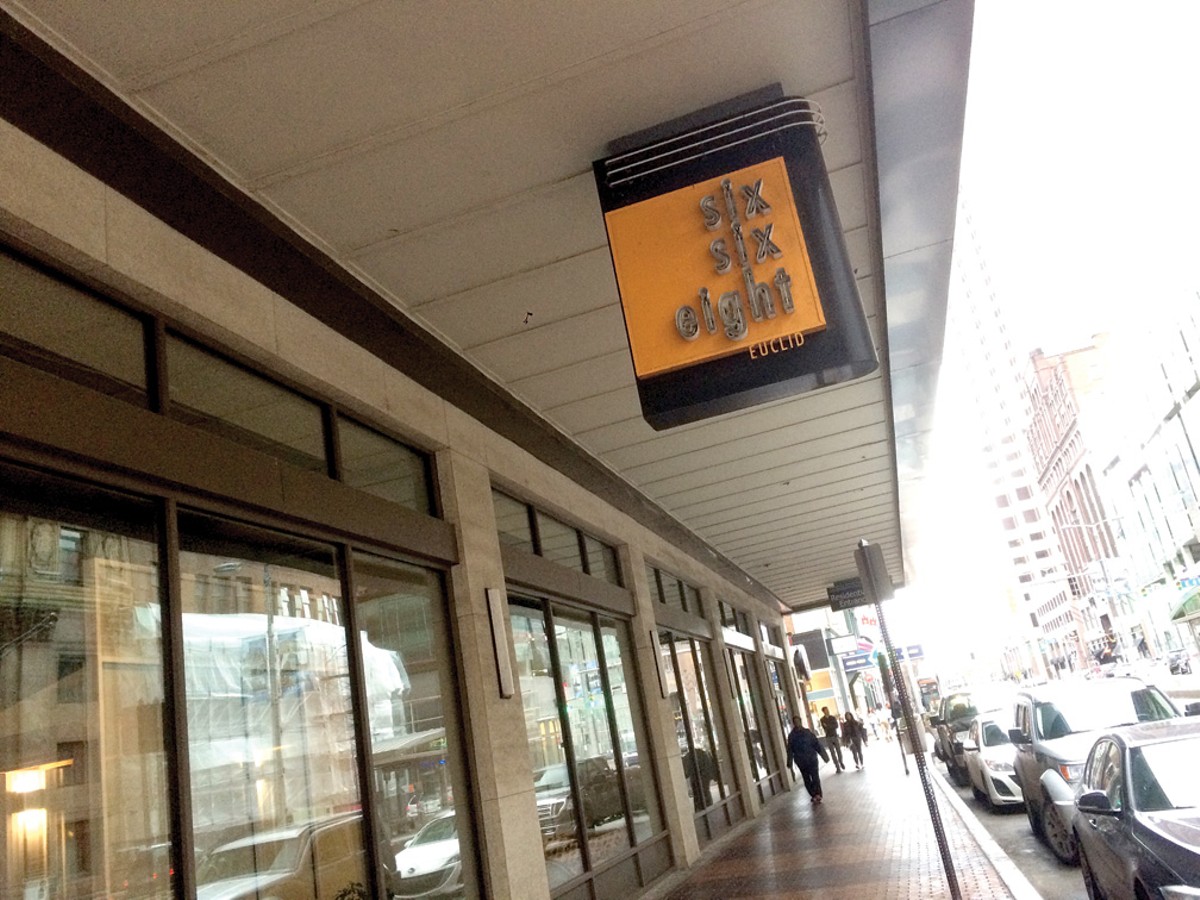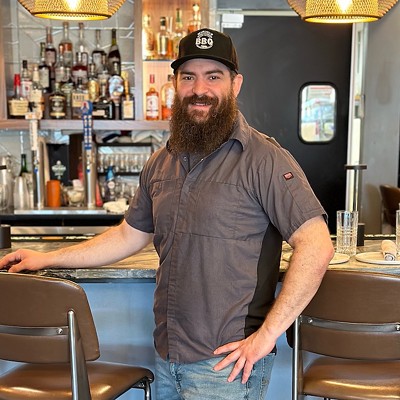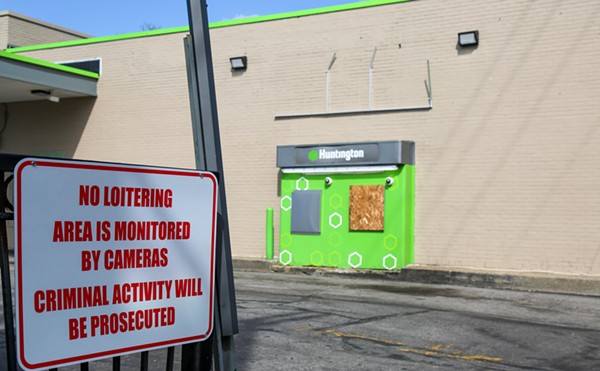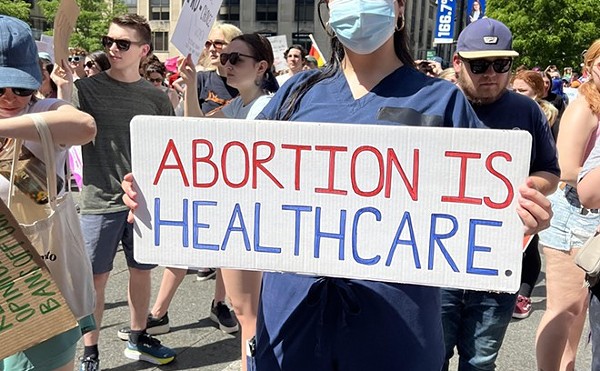The place is on the sixth floor. Two bedrooms, two and a half baths, 1,800 square feet all told, with exclusive rooftop patio access. In fact, the place is the entire sixth floor. It's been on the market for under a month by the time we show up to have a look. By the time you read this, it's long gone.
"We had to move the kitchen over a little bit and run the stairwell up to the deck," Rich Cicerchi says. He owns the East Fourth Lofts, where we are now, and he's got this one open unit available. It's primo real estate, overlooking the main nerve of Cleveland's dining scene. Below, diners flock to Greenhouse Tavern and The Butcher and the Brewer in after-work droves.
Cicerchi is joined today by Amit Patel, CEO of local "apartment search concierge" service Quo. Patel hooks up interested renters with people like Cicerchi — people who hold the keys to the New Cleveland Life and who are eagerly listing modernized apartments all over downtown. Patel says business is going exceptionally well. The steady barrage of Downtown Cleveland Alliance statistics and residential development headlines would concur.
See, downtown's residential population boom — a 97.6-percent occupancy rate with apartment-complex waiting lists that extend for "years" in some cases — is a social and economic behemoth unlike anything the city has seen in a long time. It's a new Cleveland identity entirely. It's upscale.
Moving the kitchen wall in this sixth-floor unit was a good move, it would seem, since the rooftop alone is a thing of beauty. Up top, we scan the Gateway skyline and take in a different view of this bustling city. The brickwork whispers: This could be your world.
"I wanted to show you something unique," Cicerchi says. "I could show you high rises, but you'll never get access to something like this." He's absolutely right, and so that's one important thing to bear in mind: There's still something very novel about the experience of living in downtown Cleveland. It's a thrill.
Who'd have thought that 10 years ago?
Briefly, the history of downtown Cleveland as a residential neighborhood goes like this: There were very few people living here, and then there were lots of people living here. A downtown address calling card — "I've got a place at The 9" — quickly became a point of status. Millennials, mostly, filtered through urban studies theorist Richard Florida's well-researched "creative class," arrived.
The apartment building we're checking out today anchors East Fourth Street, which for many years was little more than a half-shuttered retail alley. This building was once a light manufacturing warehouse of sorts — a holding center for theatrical equipment, mostly — meaning there was a lot of empty space arcing across thick concrete floors. Good for redevelopment into high-end lofts. This one's a beauty.
Cicerchi bought the place in 2006. The plan was to make it into condos, but when the market tanked a few years later he decided to "finish it and rent." He started with Wonder Bar on the ground level, and then worked his way up, floor by floor. This unit at the top was completed about two years ago.
"[People] want proximity to downtown, but they really want modern amenities: central air, brand new furnaces — brand new everything," Cicerchi says, rattling off the work he put into this place.
So that's what happened here. It's still happening, too, all over the city: Old buildings becoming new again.
Rents will go up as downtown continues to grow. Personally, Cicerchi sees another 10,000 people moving downtown in the coming years. There's no reason to doubt that. "Downtown" is closing in on some 15,000 residents, up 70 percent since 2000. (And in 1990, the downtown population was 4,651.) As of last fall, the Downtown Cleveland Alliance stated that, "275 apartments are currently under construction and another 4,000 are in various stages of planning."
Coming online in the next few years: major residential developments on Public Square and Johnson Court, at the May Company and Halle buildings, at the imminent nuCLEus project across the street from Quicken Loans Arena, and elsewhere, scattered like beacons in a city that's beginning to stir itself out of bed. When they open, the inevitably upscale units will greet the thousands of tenants waiting to sign leases downtown. There's no end in sight. Demand is soaring.
The Cleveland rental renaissance is here.
***"Although the downtown residential population is over 13,000, downtown Cleveland is still only scratching the surface of meeting demand for downtown living." That's the header from the Downtown Cleveland Alliance's third-quarter 2015 report. Only scratching the surface.
All those folks are packed into approximately 6,665 housing units across downtown's 3.2 square miles. Of those, only 880 are owner-occupied. That leaves 5,785 rented units downtown: 87 percent of all housing units.
There's reason to discuss the longevity and the sustainability of the downtown housing market — if not express outright concern for it. The same conversations are quietly taking place every time a new hotel project is announced downtown, for instance. "How can we fill those rooms each night?" Concern like that is not a good look for a city hellbent on a positive image, a city careening into the Republican National Convention and beyond, but it's healthy and necessary.
In this case, though, the growing worry has more to do with a residential market being built on the backs of leases and tax abatements.
Let's run the numbers.
From late 2012 to late 2015, the number of housing units for sale downtown dropped from 936 to 880. Square-foot pricing increased from $159.83 to $181.06 (with total unit price dropping from $249,132 to $197,112).
Meanwhile, in that same period, the rental market jumped from 4,636 total units to 5,785. In tandem, square-foot pricing bumped up from $1.14 to $1.33. The average monthly rent is $1,107, according to the DCA. Occupancy now hovers above 97 percent. Waiting lists in some buildings range from "40 to 100" prospective tenants per unit type (one-bedroom, two-bedroom, etc.), according to one broker.
The DCA says 1,700 people are waiting to move downtown at any given time.
In all, 18 new residential buildings have been built since the 2007 boom. Another six are currently in the midst of renovations. At least 10 more are "planned."
The DCA insists that 535,042 residents in "greater Cleveland" could afford downtown living. That's 30 percent of our five-county region. Meanwhile, median household income in Lorain, Medina, Lake, Geauga and Cuyahoga counties dances around $57,000. Based on conversations with a number of people plugged into the market, one would need to pull in $70,000 to, preferably, $80,000 yearly to live comfortably downtown. (For $35,000 or so, you can get by in the neighborhoods.)
So who's moving in?
Cicerchi and Patel agree that the two main demographics flowing into downtown find themselves at two distinct stations in life: before kids and after kids. Mainly, downtown is seeing young professionals under 35 taking up residence at any of the fine and enticing apartment complexes in the heart of the city. Also, there are plenty of empty nesters — 55 and older —either moving in wholesale or picking up a property to enjoy on the weekends or rent to whomever.
Those buyers, however, are outliers in the growth story of downtown Cleveland. And that may be an issue worth confronting in the years ahead.
***Jesse Howells, CFO at Howells & Howells Enterprises, has been living downtown since what he terms the "Wild West" days of downtown life. In 2007, he says, his father purchased the Park Building and Southworth Building on Cleveland's Public Square. That move helped return Howells to the North Shore to begin working with the family's development company. Cleveland had yet to fully transform.
He's familiar with the growth Cleveland has experienced since then, and he celebrates it. As downtown settles into a new identity — and quickly, amorphously — he's among many who are unsure of how solid that footing really is.
"The top-line, for-sale market is pretty well baked at $300 per square foot," Howells says. (In Chicago, for comparison, the same sort of supremely high-end properties might draw $600 to $1,000 per square foot.) From acquiring a building, running through a full gut and rehab job, and selling, developers are looking at a break-even proposition.
That's not a terrific backbone for the housing market here.
"The only way to make money on these deals is tax credits," Howells says. Developers can pick up 25 cents on the dollar through the state and 20 cents on the dollar through the feds, then couple that with, say, a five-year tax abatement through the city of Cleveland. Once approved, projects can skate through the build-out process and open the floodgates to easy rental revenue.
Michael Cosgrove, Cleveland's director of community development, says that there's been a general increase in tax abatement issuances over the past 10 years or so. (Tax abatements allow property owners and developers to lock in a tax rate that will not increase with time — say, for the next 15 years.) "We're seeing the new construction certainly increasing," he said. "A lot of what you're seeing downtown is market driven. Now, that market is helped by the tax abatement certainly, but a lot of it is the character of millennials and empty-nesters. The tax abatement certainly, I think, is still needed to incentivize development, not only downtown, but throughout the city."
And incentivize it has. Between 2010 and 2014, downtown saw $4.5 billion in residential and commercial development, much of it helped along by the city's policies. Howells says Cleveland has been "aces" in terms of its public handling of downtown development. Still, he says that others in the private sphere — others in his shoes from around the city — should begin discussing longer-term implications.
"Thousands of apartments coming online in the next 12 to 18 months are all going to be rentals for the next five years," Howells predicts. "What happens in year six?"
There's the central question. Everything after year five is gravy, insofar as developers simply recouping their costs. The whole framework of renting property is rather non-committal on both sides of the table, really. Always is.
"It's something fairly obvious on the surface, but something that no one talks about," Howells says.
Part of the issue — the vague concern downtown — is that the market is shifting into high gear at a weirdly fast pace. And while the pure employment tax numbers in the city make for great news each year, there hasn't been a moment to catch our breaths and reorient our civic identity.
Consider this: When LeBron James announced his return to Cleveland in the summer of 2014, and the Republican National Convention was bestowed on Cleveland around that same time, Howells sold six units that he had been sitting on for two years. Just like that. (The term "LeBronomy" is asinine, but it holds water here. This is real movement.)
But as Howells and others look around, and as the downtown rental narrative inflates further into 2016, his fear is an exodus in five years, leaving behind a ton of inventory downtown. That happens if nobody is committed to downtown through ownership.
To tackle that central question, one runs into a chicken-or-egg scenario. Does mass ownership prompt the lifestyle amenities that make a neighborhood a neighborhood? Or does it really take a Heinen's and a Geiger's to begin signaling to people that ownership — a hard stake in the community — is valuable? Howells, for one, points out that the addition of a local grocery store in the heart of downtown is a game-changer. ("You ask me that even two years ago, and there's no way," he says of the revelatory 2015 Heinen's opening.)
"It's those incentives that get the smart money to buy," Howells says. "If Cleveland over the next five years can prove to people that it's worth it to own — that type of New York mentality — that's when you're really going to see things take off. I don't think you have stability until you have ownership."
Two years ago, when downtown Cleveland's population was soaring — though still far off from where we're at today — DCA president Joe Marinucci told The New York Times that a downtown population closer to 20,000 would light up the neighborhood in "a truly round-the-clock" way. Imagine: Pedestrians flowing through the city's streets at all hours, living, working and playing.
The arc is bending in that direction. What those thousands of new residents do with the city's character will be a show worth watching.
***Scanning the market as it unspools around downtown Cleveland right now, there's ample opportunity to rent. On one hand, according to recent reports, only between 20 and 30 housing units are selling per quarter. But rentals? The second a unit becomes available, property managers hit up the waiting list and begin talking with prospective tenants. It's not hard to move an apartment unit like that in the city's core.
This is Cleveland, for now.
Amit Patel, the CEO of Quo, helps people get acquainted with the vast inventory in Cleveland. He does most of his work online — chatting and emailing with clients as they tour apartments around the city — but he's walked these buildings and he knows which lifestyle niches are satisfied by which address in town. The most common and widespread now? Luxury.
"I'm noticing a lot more are opening up their pockets, banks are lending more, and the demand is there," Patel says. He looks sunnily toward that inevitable year six — a time when he sees property owners ponying up for whatever facelifts might be needed and a time when the ongoing population boom surges to keep those properties inhabited.
Rents will surely go up. Demand, it's expected, will remain in sync with the growing supply.
Patel joins us as we tour the Bingham on a bustling afternoon. Downtown Cleveland at midday is a throbbing neighborhood in action: friends gathering for lunch; workers dashing down the street to run errands between meetings; Uber drivers threading through the buses and trolleys and delivery trucks of Euclid Avenue, then shepherding riders westward into the revitalized Flats. This is the delightful street-level consequence of having so many people down here now.
We're hoping to get a sense of what it's like to apartment-hunt in Cleveland these days, and Patel points us to the well-regarded Warehouse District building. This is one of the most popular buildings in the city. We find out very soon that if you'd like to move in, you'll have to get in line behind upwards of 100 other people. This is not unique to the Bingham, though this place has never found itself below 95-percent occupancy.
Here, a one-bedroom place will cost $1,258 to $1,575. The upper end of the three-bedroom tier, for comparison, hovers around $2,750. These are all certainly nice places, we see, but if you're trying to sneak into a downtown address for under $1,000, well, tough luck for the most part. The market is pushing quickly past that point. "West Sixth has some studio lofts that are under $1,000 — barely under $1,000," Patel says. "I mean, nothing is available right now; but yeah, there are some units up there that you can get for under $1,000."
Both anecdotes and data point to that $70,000 to $80,000 income range again as a baseline for entry to the downtown life. It's becoming part of the downtown identity — more so than ever before — and part of a further wedge between the city core's economic outlook and the city's outlying neighborhoods.
As income inequality becomes clearer in Cleveland, there's surely no sign that the willing customer base for upscale downtown rentals will slow.
"[Property managers] are really studying what their tenants are wanting," Patel says. "Yoga is a big thing now in Cleveland. So they have a yoga studio up there. Tenants don't have to go anywhere else for certain things. They're paying attention. It's not just about collecting rent."
And it's about a lot of things, actually, because the context of Cleveland's reinvention is a tapestry. This resilient city is humping the positive trends into a completely new and uncharted future. Housing, of course, plays a major role in how we'll define ourselves.
It's the story you can't escape: the evolution of Cleveland. Among the most shared stories of this so-far young year has been Cleveland's national ranking at No. 8 in terms of attracting millennial professionals. Eighth! Cleveland!
Perhaps the growth simply points to more apartments — bigger, nicer apartments with crisp lake views and hot yoga studios — hitting the market with higher, more New Yorkian rents. Maybe, as Howells might hope, we'll see more ownership flood downtown in the next five or 10 years.
"We are on the early edge of this fifth migration, and our explosive millennial population growth is changing the face and trajectory of Cleveland," said Lillian Kuri, program director for arts and urban design at the Cleveland Foundation. "We need to understand its impact on the city and the neighborhoods, and rapidly harness the local and regional resources to sustain this momentum."














